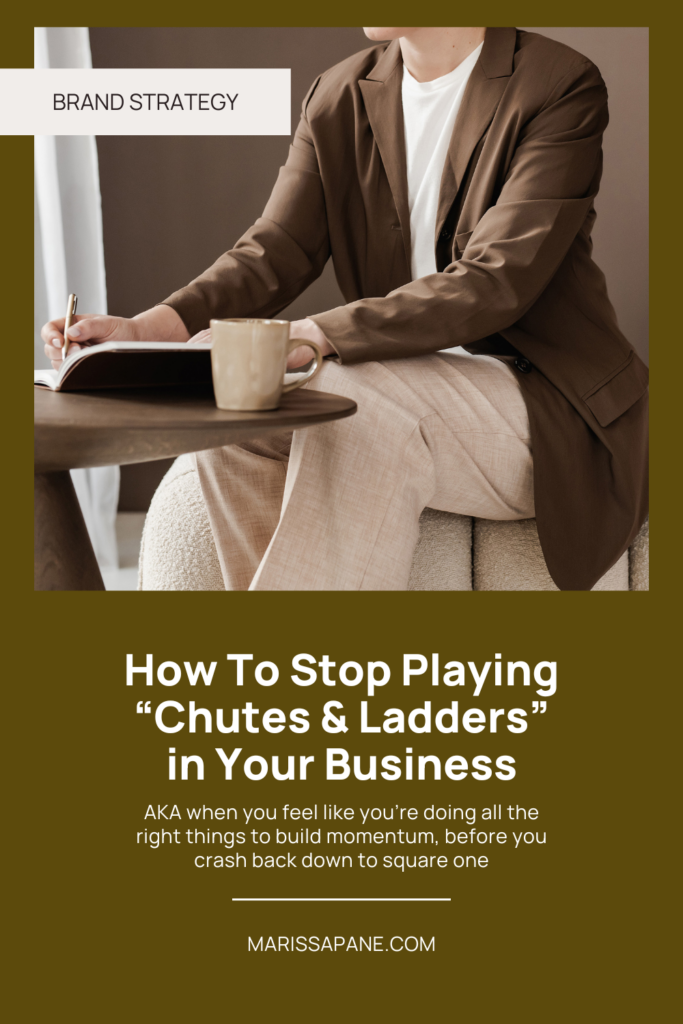🎧 Listen on: Apple Podcasts | Spotify
Right now, your business might feel like a game of Chutes and Ladders. You’re climbing ladders, making progress, and ticking off all the “must-dos” as a business owner. You hired someone to design your logo—check. You built a website—check. You’re following the blueprint that everyone says leads to success.
But then, you land on a chute. Suddenly, you’re sliding backward.
Maybe things don’t feel aligned anymore. Maybe you’re not attracting the right clients—or any clients. You’ve done everything “right,” but something isn’t clicking. Your business is stuck in an endless cycle of climbing and falling.
The Difference Between a Business and a Brand
This cycle happens when you build a business without solid brand foundations. A business can sell a product or service, but a brand is something more. A brand has depth, connection, and a clear identity.
When you build a brand, you’re no longer playing Chutes and Ladders. You’re just climbing. No more setbacks, no more sliding back to square one.
But how do you actually do this?
Step 1: Find Your Brand Voice
Your brand voice is more than a list of buzzwords like “friendly” or “professional.” To truly understand it, start by journaling about your hot takes—the opinions and insights that set you apart in your industry.
Ask yourself:
- What makes me eye-roll about my industry?
- What common advice do I completely disagree with?
- What’s my unique take on what I do?
For example, in marketing, everyone says, “Video content is king!” But I believe bad video content isn’t better than no video at all. If you look like you’re being held hostage on camera, that’s not good branding—that’s forced content. Instead, let’s find a strategy that plays to your strengths.
Your hot takes reveal your perspective, which is a crucial part of your brand’s identity.
Step 2: Record Yourself Talking About Your Work
If writing feels forced, try speaking instead. Record yourself casually explaining what you do—no script, no pressure. Then, transcribe it. You’ll start to notice patterns in your natural speech.
Want an even better way? Have a friend secretly hit “record” when you’re in the middle of a passionate rant about your industry. That’s the real you, unfiltered.
Step 3: Create a “This, Not That” List
Go beyond surface-level descriptions of your brand’s personality.
Instead of saying:
🚫 “I’m friendly.”
✅ “I’m the friend who calls you on your BS when you need it.”
🚫 “I’m professional.”
✅ “I bring deep expertise, but in a way that feels fun and engaging.”
Clarifying how you communicate builds consistency and trust in your brand.
Step 4: Ask Your Clients Why They Chose You
Your clients see your brand more clearly than you do. Instead of just asking for a testimonial, guide the conversation with questions like:
- What challenges were you facing before working with me?
- What was your experience like during the process?
- How has your business/life changed since working with me?
Their words will reveal patterns you didn’t even realize were there. You might think your clients hire you because you’re knowledgeable, but they might say they hired you because you make them feel heard and supported. That’s your real brand differentiator.
Branding Isn’t Instant, It’s an Evolution
Your brand won’t be built overnight, but the more you explore, test, and refine, the clearer it will become.
Instead of playing Chutes and Ladders with your business, let’s build something solid—something that doesn’t just exist, but truly stands out.
Are you ready to go from business to brand? Let’s make it happen.
🎧 Hit play now on: Apple Podcasts | Spotify

